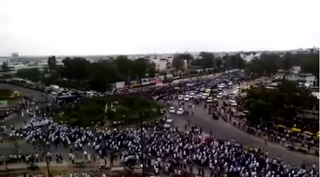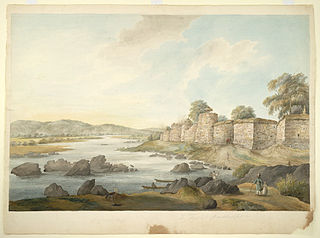Related Research Articles

Odisha, formerly Orissa, is an Indian state located in Eastern India. It is the eighth-largest state by area, and the eleventh-largest by population, with over 41 million inhabitants. The state also has the third-largest population of Scheduled Tribes in India. It neighbours the states of Jharkhand and West Bengal to the north, Chhattisgarh to the west, and Andhra Pradesh and Telangana to the south. Odisha has a coastline of 485 kilometres (301 mi) along the Bay of Bengal in Indian Ocean. The region is also known as Utkaḷa and is mentioned by this name in India's national anthem, Jana Gana Mana. The language of Odisha is Odia, which is one of the Classical languages of India.

Khatri is a caste originating from the Punjab region of South Asia that is predominantly found in India, but also in Pakistan and Afghanistan. In the Indian subcontinent, they were mostly engaged in mercantile professions such as banking and trade. They were the dominant commercial and financial administration class of late-medieval India. Some in Punjab often belonged to hereditary agriculturalist land-holding lineages, while others were engaged in artisanal occupations. Khatris of Punjab specifically were scribes and traders. They secured good employment in the Mughal imperial service by several of them taking membership in the Madrasas and learning Persian.
Patel is an Indian surname or title, predominantly found in the state of Gujarat, representing the community of land-owning farmers and later businessmen, agriculturalists and merchants. Traditionally the title is a status name referring to the village chieftains during medieval times, and was later retained as successive generations stemmed out into communities of landowners. There are roughly 500,000 Patels outside India, including about 150,000 in the United Kingdom and about 150,000 in the United States. Nearly 1 in 10 people of Indian origin in the US is a Patel.

The Chandelas of Jejakabhukti was an Indian dynasty in Central India. The Chandelas ruled much of the Bundelkhand region between the 9th and the 13th centuries. They belonged to the Chandel clan of the Rajputs.

Patidar, formerly known as Kanbi, is an Indian land-owning and peasant caste and community native to Gujarat. The community comprises at multiple subcastes, most prominently the Levas and Kadvas. They form one of the dominant castes in Gujarat. The title of Patidar originally conferred to the land owning aristocratic class of Gujarati Kanbis; however, it was later applied en masse to the entirety of the Kanbi population who lay claim to a land owning identity, partly as a result of land reforms during the British Raj.

Sambalpur is the fifth largest city in the Indian State of Odisha. It is located on the banks of river Mahanadi, with a population of 335,761. Prehistoric settlements have been recorded there. It is the home of the Sambalpuri sari.
The Karan or Karana is a community of scribes found in the state of Odisha in India. The post of Karana used to be a professional designation that was occupied by literate members of the lower as well as the higher castes. They also held Karanam post in some parts of Andhra Pradesh, where they speak Odia and played the similar role in Odisha as that of the Kayasthas of West Bengal and Bihar. Traditionally they were the official record-keepers in the royal courts of the Odia princely states historically. Today they are a politically dominant community and have reigned over the politics of Odisha for 40 years.
The Tanti bania are a Hindu vaishya cloth merchant community in India. The greatest concentration is believed to be in the states of Gujarat, Maharashtra, Jharkhand, Bihar, Uttar Pradesh, West Bengal, Assam and Odisha. The community is not very concentrated because their designation was defined based on their occupation rather than particular beliefs or group identity.
There are numerous days throughout the year celebrated as New Year's Day in the different regions of India. The observance is determined by whether the lunar, solar or lunisolar calendar is being followed. Those regions which follow the Solar calendar, the new year falls as Baisakhi in Punjab, Bohag Bihu in Assam, Puthandu in Tamil Nadu, Vishu in Kerala, Pana Sankranti or Odia Nababarsa in Odisha and Poila Boishakh in Bengal in the month of the calendar, i.e., Vaishakha. Generally, this day falls during 14th or 15th of the month of April. Those following Lunar calendar consider the month of Chaitra as the first month of the year, so the new year is celebrated on the first day of this month like Ugadi in Andhra Pradesh, Telangana, Karnataka and Gudi Padwa in Maharashtra. Similarly, few regions in India consider the period between consecutive Sankarantis as one month and few others take the period between consecutive Purnimas as a month. In Gujarat the new year is celebrated as the day after Diwali. As per the Hindu Calendar, it falls on Shukla Paksha Pratipada in the Hindu month of Kartik. As per the Indian Calendar based on Lunar Cycle, Kartik is the first month of the year and the New Year in Gujarat falls on the first bright day of Kartik (Ekam). In other parts of India, New Year Celebrations begin in the spring.

Bhima Bhoi (1850–1895) was a 19th-century saint, poet, mystic, and social reformer from the state of Odisha in India. He was a follower of Mahima Swami, and his teachings and poetry were deeply influenced by Mahima Dharma, a monotheistic religious movement in Odisha. Bhima Bhoi was a bhakta of Mahima Gosain, the founder of Satya Mahima Dharma, an Indian religious tradition that challenged the authority of caste and other forms of discrimination. Bhima Bhoi is remembered for his mystical poetry, which was primarily in the Odia language, and his social reform efforts aimed at uplifting the marginalized sections of society.
Khandayat, also spelled Khandait, is a cultivating caste, as well as a peasant militia or landed militia caste from Odisha, East India. Some of them had earlier served as feudal chiefs as well as zamindars apart from being land holders and agriculturalists. Numerically they are the largest caste of the state. During British raj, they ruled many tributary states in odisha including Khordha.

Kumhar or Kumbhar is a caste or community in India, Nepal, Bangladesh and Pakistan. 'Kumhar' have historically been associated with the art of pottery.

The Rathva or Rathwa also spelled as Rathava and Rathawa is a Subcaste of the Koli caste found in the Indian state of Gujarat. Rathava Kolis were agriculturist by profession and turbulent by habits but now lives like Adivasis such as Bhil because of their neighborhood

Pana Sankranti,, also known as Maha Bishuba Sankranti, is the traditional new year day festival of Odia people in Odisha, India. The festival occurs in the solar Odia calendar on the first day of the traditional solar month of Meṣa, hence equivalent lunar month Baisakha. This falls on the Purnimanta system of the Indian Hindu calendar. It therefore falls on 13/14 April every year on the Gregorian calendar.
The Bharbhunja are an occupational caste found in North India and Maharashtra. They are also known as Kalenra in Maharashtra. A small number are also found in the Terai region of Nepal.
The Kela are a Hindu community found in the states of Gujarat and Rajasthan in India. They are also known as Dhat Maheshwari.

The Koli is an Indian caste found in Rajasthan, Himachal Pradesh, Gujarat, Maharashtra, Uttar Pradesh, Haryana, Karnataka, Odisha and Jammu and Kashmir states in India. Koli is an agriculturist caste of Gujarat but in coastal areas they also work as fishermen along with agriculture. In the beginning of 20th century, the Koli caste was recognised as a denotified tribe under Criminal Tribes Act by the Indian Government because of their anti-social activities during World War I.
Assamese Brahmins are the Brahmins present in the Assamese society. There they promoted learning, Vedic religion, astrology, ayurveda and as well as imparting general vedic knowledge to the public. The Brahmins migrated to Assam from Videha (Mithila), Kannauj, Bengal and many other places.
The Chalukyasof Navasarika were an Indian dynasty that ruled parts of present-day Gujarat and Maharashtra during 7th and 8th centuries, as vassals of the Chalukyas of Vatapi. They are also known as the "Early Chalukyas of Gujarat".

The Bhoi dynasty or the Yaduvamsa dynasty were a medieval Hindu dynasty from the Indian subcontinent, which originated in the region of Odisha that reigned from 1541 to 1560 CE. Govinda Vidyadhara had usurped the throne from the later weaker Suryavamsa Gajapati Empire rulers as the kingdom started weakening but had a short-lived reign as ruling chiefs of Odisha as the ensuing internal rivalries and constant threats of invasions rendered them weak and were eventually overthrown by Mukunda Deva of Chalukya dynasty in 1560.
References
- ↑ Patnaik, Nihar Ranjan (1997). Economic History of Orissa. Indus Publishing. ISBN 978-81-7387-075-0.
- ↑ Hockings, Paul, ed. (1987). "kshatriya, the brave and Social Change in Gujarat". Dimensions of Social Life: Essays in Honor of David G. Mandelbaum. Walter de Gruyter. p. 499. ISBN 978-3-11084-685-0.
- ↑ Dikshit, Kamal Ramprit; Dikshit, Jutta K. (2013). North-East India: Land, People and Economy. Springer Science & Business Media. p. 370. ISBN 978-9-40077-055-3.